
by Terri Cook Tuesday, March 3, 2015
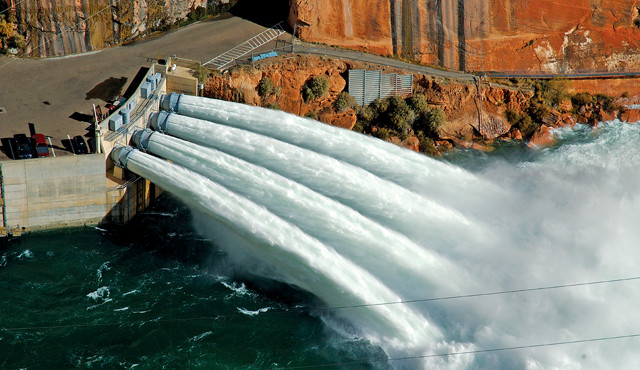
r flow experiments conducted on the Colorado River between 1996 and 2012 tested whether artificial floods released from the Glen Canyon Dam could restore downstream ecosystems. Credit: Anne Phillips, USGS.
Worldwide, dams store about 6,200 cubic kilometers of water — roughly three times the combined volume of water flowing in all of the world’s rivers at any given time. Currently, there are more than 47,000 large dams (taller than 15 meters) and at least another 800,000 smaller dams; an additional 1,600 dams are under construction. They impound an estimated 60 percent of the world’s rivers. While dams provide societal benefits, such as hydropower, water storage, flood control and economic growth, they also have many unintended consequences, such as altering the flux of water and sediment from the continents to the oceans; changing daily, seasonal and annual streamflow patterns; and fragmenting habitats and posing significant threats to freshwater biodiversity.
Studies have shown that freshwater ecosystems are losing species faster than terrestrial or marine systems, and that at least 25 percent of the world’s roughly 9,000 freshwater fish species have become extinct, threatened or endangered in recent decades. Many researchers now consider these ecosystems to be the most endangered on Earth.
In the last decade, the public has grown more aware of the environmental impact of dams, raising interest in trying to reverse these impacts. Scientists and dam managers are beginning to consider the very dams that disrupt ecosystems as promising tools for restoring rivers through controlled releases of water known as large-scale flow experiments, or FEs.
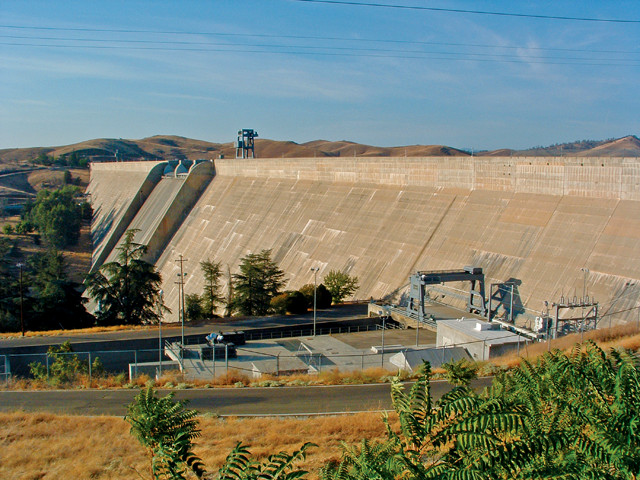
ter Friant Dam in California was built in 1942, a 96-kilometer-long stretch of the San Joaquin River was dry for nearly half a century, eliminating natural runs of the Chinook salmon. Restoration flows and the experimental reintroduction of salmon occurred after a lawsuit was settled in 2006. Credit: ©Kjkolb, CC BY SA 2.5
The flows of undammed rivers are often highly variable, both seasonally and year-to-year, and native fish and other freshwater species are adapted to these changes. However, dams typically attenuate or eliminate this natural variability. They can also shift the timing of seasonal flow differences, alter water temperatures and increase base flows and daily water-level fluctuations, particularly when the water is used to generate hydroelectricity.
Because aquatic and terrestrial organisms in fluvial habitats have evolved in response to the natural ebb and flow of the river, the changes wrought by a dam can reverberate throughout an ecosystem, interrupting life cycles, reducing growth rates, decreasing diversity and potentially altering the base of the food web upon which the ecosystem depends.
In the absence of dams, natural seasonal floods “create and maintain habitats, recruit wood and sediment to the river, and transport organic material and nutrients between rivers and floodplains,” says Christopher Konrad, a research hydrologist at the U.S. Geological Survey’s (USGS) Washington Water Science Center in Tacoma, Wash., and a co-author of a 2014 meta-analysis of flow experiments published in Frontiers in Ecology and the Environment. “Without these floods,” he says, “river habitats are simplified.”
After a river has been dammed, organisms that are adapted to floods — such as fish that use flooding as a cue for spawning — are no longer in sync with their environment, Konrad says. When snowmelt that would have flowed downstream as a spring flood is instead impounded behind a dam, the fish never receive that cue. In addition, the lack of periodic disturbances will favor species that aren’t adapted to flooding — such as fish that inhabit lakes — and allow vegetation to become established along banks and stabilize them, he says. This stabilization ultimately reduces the amount of shallow water along the edges of the river on which some organisms, such as juvenile fish, rely.
The specific ecological impacts on downstream ecosystems depend upon many factors, including the physical setting, the affected organisms, and the purposes the dam serves, such as power generation, water supply or flood control.
Water-supply dams are designed to capture high-flow events and release the water when needed for irrigation or power generation. This can rearrange seasonal water-flow patterns, storing wet-season flows to release during the dry season. Such operations can substantially reduce the amount of water flowing downriver, or at times even stop the flow completely. This occurred for nearly half a century along a 96-kilometer-long stretch of California’s San Joaquin River after the U.S. Bureau of Reclamation built the Friant Dam in 1942 to supply irrigation water to farmers in the region.
Due to these diversions, the San Joaquin’s natural spring and fall runs of Chinook salmon were eliminated, although hatchery releases sustained a small population of fall-run Chinook that spawn in the major tributaries. But following the 2006 settlement of a lawsuit brought by the Natural Resources Defense Council, the National Audubon Society, Trout Unlimited of California and other groups, the dam operators have implemented restoration flows, enabling the National Marine Fisheries Service to begin experimental reintroduction of the endangered Chinook to determine how the salmon respond to alterations in river flow and water exports.
Meanwhile, large hydroelectric dams with sizeable reservoirs are able to capture high water flows and store them for later use to generate hydropower. This results in lowered flood peaks followed by rapidly fluctuating water levels corresponding to periods of high and low electricity demand. Rapid fluctuations can cause considerable ecological damage: Slow-moving aquatic organisms like mussels may be stranded when levels drop, for example, or swept away when water levels rise too quickly. Elimination of small floods and the reduction (and sometimes elimination) of base flows can also have negative ecological consequences.
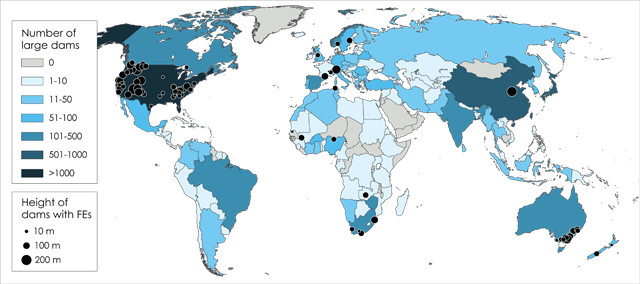
Most flow experiments happen in countries with large dams. Credit: Kathleen Cantner, AGI, after Olden et al., Frontiers in Ecology and the Environment, 2014.
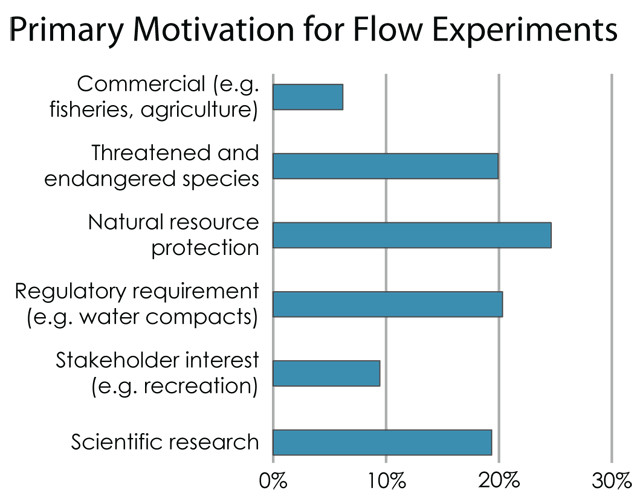
One of the primary motivations for doing flow experiments is to more closely mimic natural flows to protect threatened or endangered species. Credit: Kathleen Cantner, AGI, after Olden et al., Frontiers in Ecology and the Environment, 2014.
Large-scale flow experiments aim to recreate some of the same ecological functions that natural variability once accomplished. So far, they have been conducted at 102 dams in 20 countries across five continents, according to the 2014 Frontiers in Ecology and the Environment study, led by Julian Olden, an associate professor in the University of Washington’s School of Aquatic and Fishery Sciences.
The authors define a large-scale flow experiment as a deliberate manipulation of streamflow for ecological purposes, rather than a release for power generation, water supply or recreational purposes. “Each experiment must meet two criteria,” Olden says. “It must be conducted downstream of a large dam, and the manipulation must involve a substantial deviation from present-day dam releases.”
He and his colleagues also emphasized that a flow manipulation is only an experiment if testable hypotheses are evaluated using new data and analyses, such as whether high flows can reduce macrophyte (macroscopic aquatic plant) cover, which is typically less abundant in rivers that experience regular floods. Unchecked growth of macrophytes can reduce available habitat or spawning grounds for some species of fish.
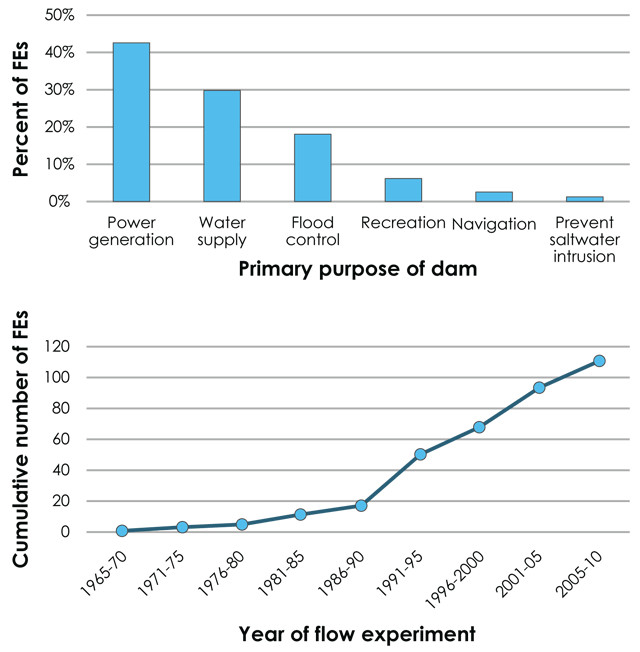
Top: Most flow experiments are conducted on dams whose primary purpose is power generation. Bottom: The number of flow experiments being conducted has risen since the early 1990s, driven by changes in attitudes about the environmental impacts of dams. Credit: Kathleen Cantner, AGI, after Olden et al., Frontiers in Ecology and the Environment, 2014.
Primary motivations for FEs generally include preservation of threatened and endangered species and restoration of iconic locations. For example, a series of artificial floods on South Africa’s Groot River were designed to initiate spawning of the endangered smallscale redfin minnow (Pseudobarbus asper). In the Grand Canyon, repeated floods along the Colorado River have been released in efforts to mobilize sediment and rebuild backwater habitats to help endangered species.
Among the 113 experiments reviewed in the study by Olden’s team, other goals ranged from reducing salinity in the Campaspe River in Victoria, Australia, to restoring wetland vegetation and waterfowl nesting habitat along Tunisia’s Ichkeul River, to increasing survival and reproduction rates in commercial salmon populations in Norway’s Gudbrandsdalslågen River.
The flow experiments studied different ecosystems. The vast majority — 83 percent — were conducted to gauge how water management actions affected river ecosystems. Of the remaining 17 percent, 10 percent assessed the impacts on floodplain ecosystems, 5 percent evaluated impacts on estuarine ecosystems, and 2 percent looked at lake ecosystems. The FEs encompassed a range of flow manipulations, the majority of which were high-flow pulses (“artificial floods”) and minimum flow experiments, such as establishing summer base flows. More than half of the FEs involved megadams, which exceed 50 meters in height. “FEs have typically involved large dams because these structures are deemed to have the largest downstream ecological effects and the greatest scope in terms of manipulating the flow regimes,” Olden says.
One of the most important models for designing the flow experiments in the Grand Canyon (and a number of other rivers) is the Spöl River in Italy and Switzerland. The Spöl is an alpine stream that flows north from the Livigno Reservoir on the border of Italy and Switzerland t National Park before joining the Inn River, a tributary of the Danube, 28 kilometers downstream.
Management of the Spöl arguably offers the best example of a long-term strategy for using carefully designed and meticulously monitored floods to restore and sustain a river’s ecological integrity, says Ted Melis, a physical scientist at the USGS Grand Canyon Monitoring and Research Center in Flagstaff, Ariz., who is also a co-author of the Frontiers in Ecology and the Environment study.
The Spöl is very unusual in how regularly it has been flooded, Melis says. Most FEs are one-time events that lack monitoring of many, or sometimes any, species. When monitoring is done, it is often not carried out long enough to detect changes in the ecosystem or in species whose life cycles span longer time periods.
“The Spöl was one of only two examples of river projects that we could identify where monitoring or repeated controlled flooding with a focus on the responses of aquatic and terrestrial species had been approved,” Melis says.
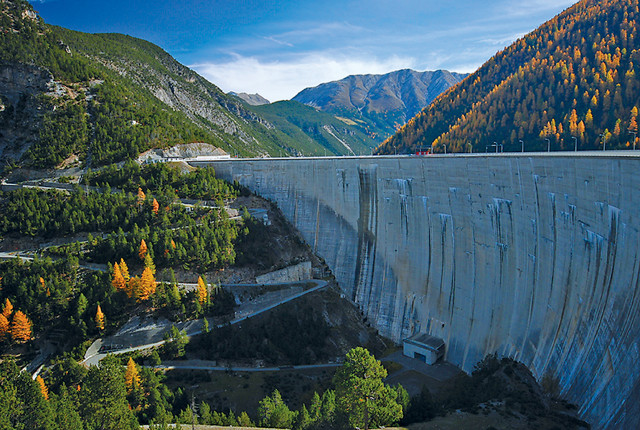
The Punt dal Gall Dam on the Spöl River on the border of Italy and Switzerland. Credit: ©Vasile Cotovanu, CC BY 2.0.
In the 1950s, Italy and Switzerland agreed to use water from the Spöl to generate electricity, a controversial decision vigorously opposed at the time by environmental organizations and managers of the national park. Following a contentious campaign, Swiss voters decided in favor of the project and, in the 1960s, the 130-meter-high Punt dal Gall Dam and the 73-meter-high Ova Spin Dam were built.
In the late 1980s, a series of studies in the national park confirmed that two decades of reduced flows had impeded the normal transport of sediment downstream, allowing fine-grained sediments to build up in the riverbed. This degraded fish spawning grounds and allowed woody vegetation, including fir trees, to grow in the channel. In addition, the water being released from the base of the dam came from deep in the reservoir, which altered the river’s natural ecological characteristics. “Water from storage release reservoirs is typically warmer in winter and colder in summer than natural systems, if they are deep-release systems like the Spöl,” says Christopher Robinson, a senior research scientist in the stream ecology group at the Swiss Federal Institute of Aquatic Science and Technology/ETH Zurich and co-author of the Frontiers in Ecology and the Environment study.
Efforts to restore the Spöl’s ecosystems with controlled floods began in 1999, and the first artificial flood rushed down the river in 2000. The first flood clearly improved the ecological conditions downstream of the dam, Robinson says, flushing much of the fine sediment from the riverbed and decreasing the dense populations of mosses, filamentous algae, and bottom-dwelling fauna that had colonized the river in the absence of natural floods. In the absence of the flood program, the river would revert back to the pre-flood condition within a few years, indicating that a single artificial flood could not sustain the river’s ecological integrity for long.
Swiss National Park authorities and representatives of the Engadin Hydroelectric Power Co., which operates the dams, gradually began working together to design and implement a flood-release program to improve the Spöl’s long-term ecological health. Now, the Spöl’s ongoing flood program typically releases two artificial floods each year — one in spring to simulate snowmelt runoff, and one in September to clear bottom sediments to optimize fish spawning in October, when the local brown trout lay eggs.
Studies by Robinson and colleagues published in the journal Ecological Applications in 2008 and 2012, and a 2011 study in the Journal of the North American Benthological Society, examined the effects of the experimental floods unleashed on the Spöl, including 29 floods released between 2000 and 2015. Through ecological monitoring programs that tracked the floods, researchers discovered that floods of 25 to 30 cubic meters per second are optimal for ecology. The floods had improved conditions for the native brown trout fishery. In addition, the floods increased the density of populations of bottom-dwelling macroinvertebrates, such as stoneflies and caddisflies, and shifted communities toward an assemblage more typical of a healthy alpine stream.
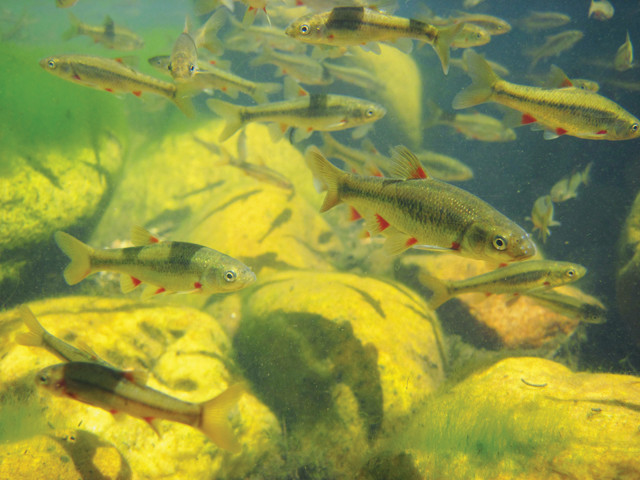
A series of artificial floods on South Africa's Groot River were designed to initiate spawning of the endangered smallscale redfin minnow. Credit: Craig Garrow.
Not all dammed rivers are managed as well as the Spöl, however. Despite evidence showing the benefits of large-scale flow experiments in restoring rivers, managing water resources for ecological outcomes can be contentious, Konrad says. Because the manipulations have uncertain outcomes, they are often perceived as high-risk management actions.
“For water managers, FEs represent a risk if they are asked to store and release water in ways that are outside of their usual operating rules,” Konrad says. “For stakeholders, FEs can represent a use of water resources that does not support — or even threatens — their uses.”
For example, flow experiments conducted at hydroelectric dams, which in the U.S. often involve many stakeholders including the federal government, often come at the cost of lost power revenues. In 2005, deliberate spills to allow fish passage at four dams on the Columbia River cost an estimated $57 million to $81 million in foregone power revenue. And between 1996 and 2012, four artificial floods unleashed from the Glen Canyon Dam, which is mainly used for water storage and hydroelectricity, cost an estimated $12 million.
For scientists, FEs also present some risks. They require plans about how to release the water and forecasts of what the likely outcomes from those releases will be. “Without prior examples, these predictions can be pretty speculative,” Konrad says.
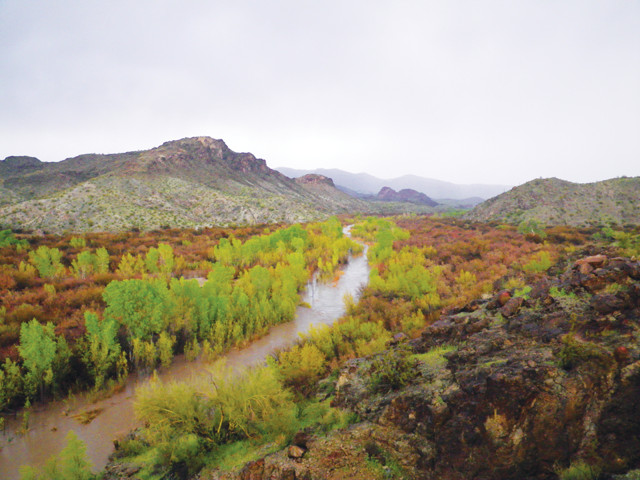
A controlled flood in progress on the Bill Williams River in Arizona, where flow experiments have successfully restored some of the river's willow and cottonwood populations. Credit: Patrick Shafroth.
Determining if a flow experiment is successful or not is yet another challenge. In their review study, Olden and his co-authors assessed the design, implementation and outcome of each of the 113 flow experiments. “Success can be defined in a number of ways,” Olden says. “Many people may value ecological outcomes in the form of goods and services they wish to sustain or improve as a result of a flow experiment; for example, enhanced sport-fishing opportunities or more exhilarating downstream rapids to kayak,” Olden says. “Others may value increases in suitable habitat for native species of conservation concern.”
Konrad argues that because flow experiments are primarily intended to achieve ecological outcomes, they must be carefully designed to develop a detectable and measurable change in the ecosystem that allows researchers to make pre- and post-flood comparisons — a standard that Olden’s study found many experiments have failed to meet. Olden adds that flow experiments must also have clearly defined experimental objectives, such as whether a series of floods will cause a shift in the ecosystem over time — the hypothesis that was tested on the Spöl.
The success of the prolonged Spöl flooding program in accomplishing a shift back toward species that are adapted to a naturally flooding river provides strong evidence that realizing the ecological and social benefits of flow experiments takes time — likely years to decades — due to aquatic species’ life cycles and the rates at which natural river processes occur, according to a 2011 study led by Konrad and published in the journal BioScience.
Fully understanding the outcomes of FEs on river systems requires both short- and long-term data collection. However, Olden and colleagues found that only 60 percent of large-scale flow experiments have established monitoring programs lasting at least one year, and only 32 percent have included multiple flow manipulations.
In addition, despite the widely reported importance of how flow variability affects ecosystems, about 80 percent of FEs have only investigated the effects of a small range of one-time flow events, greatly limiting their potential to inform environmental policy. That’s why the Spöl, which allowed researchers to test the long-term effects of a regular series of FEs, is such an important example, Melis says. And why more long-term experiments, which better approximate the normal variability of river flows over time, are needed.
To maximize the results of future large-scale flow experiments, researchers and managers will need to do more FEs in different contexts — geographical, sociopolitical and ecological — and ensure that the results are relevant to more than just one project, Olden says.
So far, flow experiments are more common in countries with a greater number of dams, such as the United States, South Africa and Australia. However, some regions that have many large dams — including Southeast Asia, South America, and western and northern Europe — are conducting few FEs. “More science is still needed in some regions, including many countries that are just now ramping up their dam construction activities,” Olden says.
Dams being built in those areas could be designed to make controlled floods easier to carry out and more effective, Melis says. In the past, the inability of dam managers to manipulate both flow and temperature during some FEs has repeatedly been cited as an obstacle. “For dams that have not already been built, it would be useful to consider the possible range of flow and temperature alterations that will occur, then design the infrastructure with FEs in mind,” Melis says.
Olden says that enhanced collaboration between scientists, managers and policymakers involved in FEs is crucial to supporting sustainable freshwater management. “Scientists should strive to develop FEs that inform river management and advance scientific knowledge,” he says. “At the same time, managers and policymakers must embrace both the scientific uncertainty and learning opportunities that inevitably arise from these experiments, and not ignore uncertainty to avoid complicating their message to stakeholders,” he says.
By working together to embrace new thinking and effectively utilize the wealth of knowledge gained from past large-scale flow experiments, “future FEs will represent a critical part of strategic efforts to credibly guide water policies and decisions, and to protect freshwater ecosystems around the globe,” Olden says.
© 2008-2021. All rights reserved. Any copying, redistribution or retransmission of any of the contents of this service without the expressed written permission of the American Geosciences Institute is expressly prohibited. Click here for all copyright requests.